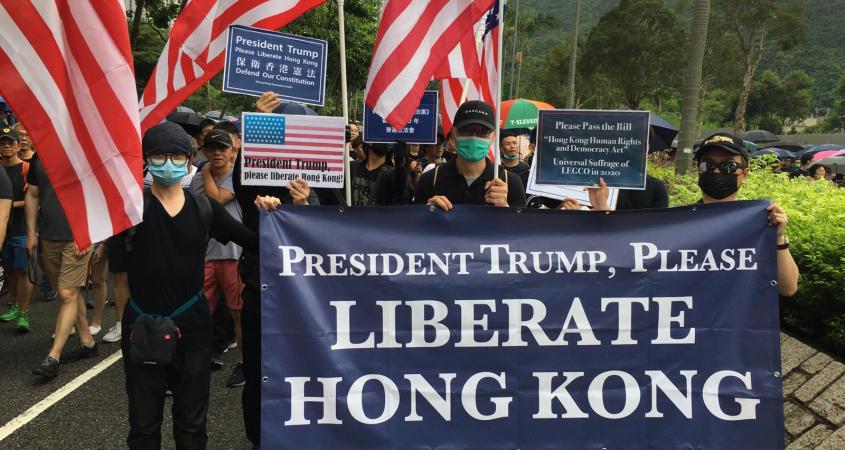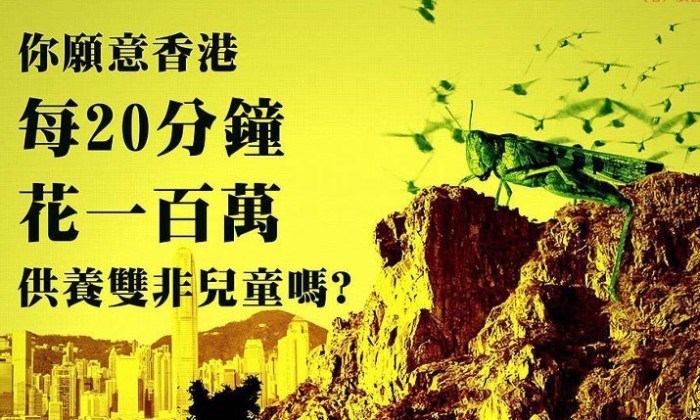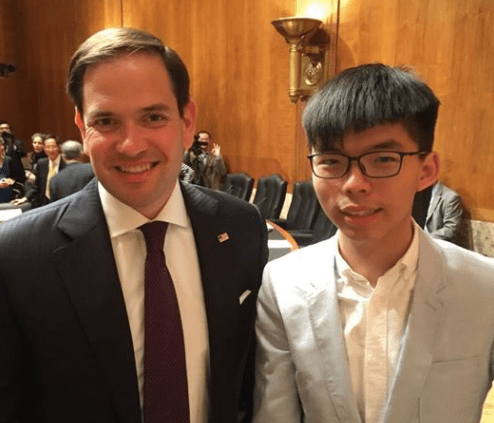Behind a Made-For-TV Hong Kong Protest Narrative, Washington Is Backing Nativism and Mob Violence
ANALYSIS, ANGLO AMERICA, ASIA--PACIFIC, BRICS, MEDIA, 26 Aug 2019
Dan Cohen | The Grayzone – TRANSCEND Media Service
Hong Kong’s increasingly xenophobic protests are devolving into chaos with help from US government regime-change outfits and a right-wing local media tycoon with close ties to hardliners in Washington.
17 Aug 2019 – President Donald Trump tweeted on August 13 that he “can’t imagine why” the United States has been blamed for the chaotic protests that have gripped Hong Kong.
Trump’s befuddlement might be understandable considering the carefully managed narrative of the US government and its unofficial media apparatus, which have portrayed the protests as an organic “pro-democracy” expression of grassroots youth. However, a look beneath the surface of this oversimplified, made-for-television script reveals that the ferociously anti-Chinese network behind the demonstrations has been cultivated with the help of millions of dollars from the US government, as well as a Washington-linked local media tycoon.
Since March, raucous protests have gripped Hong Kong. In July and August, these demonstrations transformed into ugly displays of xenophobia and mob violence.
The protests ostensibly began in opposition to a proposed amendment to the extradition law between Hong Kong, Taiwan, mainland China, and Macau, which would have allowed Taiwanese authorities to prosecute a Hong Kong man for murdering his pregnant girlfriend and dumping her body in the bushes during a vacation to Taiwan.
Highly organized networks of anti-China protesters quickly mobilized against the law, compelling Hong Kong Chief Executive Carrie Lam to withdraw the bill.
But the protests continued even after the extradition law was taken off the table — and these demonstrations degenerated into disturbing scenes. In recent days, hundreds of masked rioters have occupied the Hong Kong airport, forcing the cancellation of inbound flights while harassing travelers and viciously assaulting journalists and police.
Fu Guohao, reporter of GT website is being seized by demonstrators at HK airport. I affirm this man being tied in this video is the reporter himself. He has no other task except for reporting. I sincerely ask the demonstrators to release him. I also ask for help of West reporters pic.twitter.com/sbFb0L3s92
— Hu Xijin 胡锡进 (@HuXijin_GT) August 13, 2019
The protesters’ stated goals remain vague. Joshua Wong, one of the most well known figures in the movement, has put forward a call for the Chinese government to “retract the proclamation that the protests were riots,” and restated the consensus demand for universal suffrage.
Wong is a bespectacled 22-year-old who has been trumpeted in Western media as a “freedom campaigner,” promoted to the English-speaking world through his own Netflix documentary, and rewarded with the backing of the US government.
But behind telegenic spokespeople like Wong are more extreme elements such as the Hong Kong National Party, whose members have appeared at protests waving the Stars and Stripes and belting out cacophonous renditions of the Star-Spangled Banner. The leadership of this officially banned party helped popularize the call for the full independence of Hong Kong, a radical goal that is music to the ears of hardliners in Washington.
Xenophobic resentment has defined the sensibility of the protesters, who vow to “retake Hong Kong” from Chinese mainlanders they depict as a horde of locusts. The demonstrators have even adopted one of the most widely recognized symbols of the alt-right, emblazoning images of Pepe the Frog on their protest literature. While it’s unclear that Hong Kong residents see Pepe the same way American white nationalists do, members of the US far-right have embraced the protest movement as their own, and even personally joined their ranks.
Hong Kong protesters fly high Pepe the Frog Flag. LMAO pic.twitter.com/cD0dRm5wwy
— Carl Zha (@CarlZha) August 10, 2019
Among the most central influencers of the demonstrations is a local tycoon named Jimmy Lai. The self-described “head of opposition media,” Lai is widely described as the Rupert Murdoch of Asia. For the masses of protesters, Lai is a transcendent figure. They clamor for photos with him and applaud the oligarch wildly when he walks by their encampments.
Lai established his credentials by pouring millions of dollars into the 2014 Occupy Central protest, which is known popularly as the Umbrella Movement. He has since used his massive fortune to fund local anti-China political movers and shakers while injecting the protests with a virulent brand of Sinophobia through his media empire.
httpv://www.youtube.com/watch?v=OSUSVgLgZx0
Though Western media has depicted the Hong Kong protesters as the voice of an entire people yearning for freedom, the island is deeply divided. This August, a group of protesters mobilized outside Jimmy Lai’s house, denouncing him as a “running dog” of Washington and accusing him of national betrayal by unleashing chaos on the island.
#HongKong tycoon Jimmy Lai criticized as conspirator behind violence in HK pic.twitter.com/B9PFgtK2YP
— CGTN (@CGTNOfficial) August 11, 2019
Days earlier, Lai was in Washington, coordinating with hardline members of Trump’s national security team, including John Bolton. His ties to Washington run deep — and so do those of the front-line protest leaders.
Millions of dollars have flowed from US regime-change outfits like the National Endowment for Democracy (NED) into civil society and political organizations that form the backbone of the anti-China mobilization. And Lai has supplemented it with his own fortune while instructing protesters on tactics through his various media organs.
With Donald Trump in the White House, Lai is convinced that his moment may be on the horizon. Trump “understands the Chinese like no president understood,” the tycoon told the Wall Street Journal. “I think he’s very good at dealing with gangsters.”
‘Stop unlimited invasion of mainland pregnant women!’
Born in the mainland in 1948 to wealthy parents, whose fortune was expropriated by the Communist Party during the revolution the following year, Jimmy Lai began working at 9 years old, carrying bags for train travelers during the hard years of the Great Chinese Famine.
Inspired by the taste of a piece of chocolate gifted to him by a wealthy man, he decided to smuggle himself to Hong Kong to discover a future of wealth and luxury. There, Lai worked his way up the ranks of the garment industry, growing enamored with the libertarian theories of economists Friedrich Hayek and Milton Friedman, the latter of whom became his close friend.
Friedman is famous for developing the neoliberal shock therapy doctrine that the US has imposed on numerous countries, resulting in the excess deaths of millions. For his part, Hayek is the godfather of the Austrian economic school that forms the foundation of libertarian political movements across the West.
Lai built his business empire on Giordano, a garment label that became one of Asia’s most recognizable brands. In 1989, he threw his weight behind the Tiananmen Square protests, hawking t-shirts on the streets of Beijing calling for Deng Xiaoping to “step down.”
Lai’s actions provoked the Chinese government to ban his company from operating on the mainland. A year later, he founded Next Weekly magazine, initiating a process that would revolutionize the mediascape in Hong Kong with a blend of smutty tabloid-style journalism, celebrity gossip and a heavy dose of anti-China spin.
The vociferously anti-communist baron soon became Hong Kong’s media kingpin, worth a whopping $660 million in 2009.
Today, Lai is the founder and majority stakeholder of Next Digital, the largest listed media company in Hong Kong, which he uses to agitate for the end of what he calls the Chinese “dictatorship.”
His flagship outlet is the popular tabloid Apple Daily, employing the trademark mix of raunchy material with a heavy dose of xenophobic, nativist propaganda.
In 2012, Apple Daily carried a full page advertisement depicting mainland Chinese citizens as invading locusts draining Hong Kong’s resources. The advertisement called for a stop to the “unlimited invasion of mainland pregnant women in Hong Kong.” (This was a crude reference to the Chinese citizens who had flocked to the island while pregnant to ensure that their children could earn Hong Kong residency, and resembled the resentment among the US right-wing of immigrant “anchor babies.”)
The transformation of Hong Kong’s economy has provided fertile soil for Lai’s brand of demagoguery. As the country’s manufacturing base moved to mainland China after the golden years of the 1980s and ‘90s, the economy was rapidly financialized, enriching oligarchs like Lai. Left with rising debt and dimming career prospects, Hong Kong’s youth became easy prey to the demagogic politics of nativism.
Many protesters have been seen waving British Union Jacks in recent weeks, expressing a yearning for an imaginary past under colonial control which they never personally experienced.
In July, protesters vandalized the Hong Kong Liaison Office, spray-painting the word, “Shina” on its facade. This term is a xenophobic slur some in Hong Kong and Taiwan use to refer to mainland China. The anti-Chinese phenomenon was visible during the 2014 Umbrella movement protests as well, with signs plastered around the city reading, “Hong Kong for Hong Kongers.”
支那(Shina) is Japanese word for China that became derogatory during Sino-Japanese War. Post-War Japan gov ban its use in Kanji form (Chinese characters) in official document. Yet some people in Hong Kong and Taiwan use it to insult people from Chinese mainland. It=“Chink” in Eng https://t.co/Oe8LCXgak8
— Carl Zha (@CarlZha) July 22, 2019
This month, protesters turned their fury on the Hong Kong Federation of Trade Unions, spray-painting “rioters” on its office. The attack represented resentment of the left-wing group’s role in a violent 1967 uprising against the British colonial authorities, who are now seen as heroes among many of the anti-Chinese demonstrators.
Besides Lai, a large part of the credit for mobilizing latent xenophobia goes to the right-wing Hong Kong Indigenous party leader Edward Leung. Under the direction of the 28-year-old Leung, his pro-independence party has brandished British colonial flags and publicly harassed Chinese mainland tourists. In 2016, Leung was exposed for meeting with US diplomatic officials at a local restaurant.
Though he is currently in jail for leading a 2016 riot where police were bombarded with bricks and pavement – and where he admitted to attacking an officer – Leung’s rightist politics and his slogan, “Retake Hong Kong,” have helped define the ongoing protests.
A local legislator and protest leader described Leung to the New York Times as “the Che Guevara of Hong Kong’s revolution,” referring without a hint of irony to the Latin American communist revolutionary killed in a CIA-backed operation. According to the Times, Leung is “the closest thing Hong Kong’s tumultuous and leaderless protest movement has to a guiding light.”
The xenophobic sensibility of the protesters has provided fertile soil for Hong Kong National Party to recruit. Founded by the pro-independence activist Andy Chan, the officially banned party combines anti-Chinese resentment with calls for the US to intervene. Images and videos have surfaced of HKNP members waving the flags of the US and UK, singing the Star Spangled Banner, and carrying flags emblazoned with images of Pepe the Frog, the most recognizable symbol of the US alt-right.
While the party lacks a wide base of popular support, it is perhaps the most outspoken within the protest ranks, and has attracted disproportionate international attention as a result. Chan has called for Trump to escalate the trade war and accused China of carrying out a “national cleansing” against Hong Kong. “We were once colonised by the Brits, and now we are by the Chinese,” he declared.
Protesters in Hong Kong waving the American flag and singing the American National anthem as they advocate for democracy. Wow! pic.twitter.com/CKyFstud22
— Kaya Jones (@KayaJones) August 12, 2019
Displays of pro-American jingoism in the streets of Hong Kong have been like catnip for the international far-right.
Patriot Prayer founder Joey Gibson recently appeared at an anti-extradition protest in Hong Kong, livestreaming the event to his tens of thousands of followers. A month earlier, Gibson was seen roughing up antifa activists alongside ranks of club wielding fascists. In Hong Kong, the alt-right organizer marveled at the crowds.
“They love our flag here more than they do in America!” Gibson exclaimed as marchers passed by, flashing him a thumbs up sign while he waved the Stars and Stripes.
‘British colonial past gave us the instinct to revolt’
Such xenophobic propaganda is consistent with the clash of civilizations theory that Jimmy Lai has promulgated through his media empire.
“You have to understand the Hong Kong people – a very tiny 7 million or 0.5 percent of the Chinese population – are very different from the rest of Chinese in China, because we grow up in the Western values, which was the legacy of the British colonial past, which gave us the instinct to revolt once this extradition law was threatening our freedom,” Lai told Fox News’ Maria Bartiromo. “Even America has to look at the world 20 years from now, whether you want the Chinese dictatorial values to dominate this world, or you want the values that you treasure [to] continue.”
During a panel discussion at the neoconservative Washington-based think tank, the Foundation For Defense of Democracies, Lai told the pro-Israel lobbyist Jonathan Schanzer, “We need to know that America is behind us. By backing us, America is also sowing to the will of their moral authority because we are the only place in China, a tiny island in China, which is sharing your values, which is fighting the same war you have with China.”
While Lai makes no attempt to conceal his political agenda, his bankrolling of central figures in the 2014 Occupy Central, or Umbrella movement protests, was not always public.
Leaked emails revealed that Lai poured more than $1.2 million to anti-China political parties including $637,000 USD to the Democratic Party and $382,000 USD to the Civic Party. Lai also gave $115,000 USD to the Hong Kong Civic Education Foundation and Hong Kong Democratic Development Network, both of which were co-founded by Reverend Chu Yiu-ming. Lai also spent $446,000 USD on Occupy Central’s 2014 unofficial referendum.
Lai’s US consigliere is a former Navy intelligence analyst who interned with the CIA and leveraged his intelligence connections to build his boss’s business empire. Named Mark Simon, the veteran spook arranged for former Republican vice-presidential candidate Sarah Palin to meet with a group in the anti-China camp during a 2009 visit to Hong Kong. Five years later, Lai paid $75,000 to neoconservative Iraq war author and US Deputy Secretary of Defense Paul Wolfowitz to organize a meeting with top military figures in Myanmar.
This July, as the Hong Kong protests gathered steam, Lai was junketed to Washington, DC for meetings with Vice President Mike Pence, Secretary of State Mike Pompeo, National Security Advisor John Bolton, and Republican Senators Ted Cruz, Cory Gardner, and Rick Scott. Bloomberg News correspondent Nicholas Wadhams remarked on Lai’s visit, “Very unusual for a [non-government] visitor to get that kind of access.”
Today: Hong Kong publisher and democracy advocate Jimmy Lai met National Security Adviser John Bolton in DC. After meetings with @SecPompeo and @VP, this is meant to send a signal to Beijing. Very unusual for a nongovt visitor to get that kind of access. pic.twitter.com/6rvqsGJzru
— Nick Wadhams (@nwadhams) July 10, 2019
One of Lai’s closest allies, Martin Lee, was also granted an audience with Pompeo, and has held court with US leaders including Nancy Pelosi and former Vice President Joseph Biden.
Among the most prominent figures in Hong Kong’s pro-US political parties, Lee began collaborating with Lai during the 1989 Tiananmen Square protests. A recipient of the US government-funded National Endowment for Democracy’s “Democracy Award” in 1997, Lee is the founding chairman of Hong Kong’s Democratic Party, now considered part of the pro-US camp’s old guard.
While Martin Lee has long been highly visible on the pro-western Hong Kong scene, a younger generation of activists emerged during the 2014 Occupy Central protests with a new brand of localized politics.
Teenager Vs. Superpower, with help from a bigger superpower
Joshua Wong was just 17 years old when the Umbrella Movement took form in 2014. After emerging in the protest ranks as one of the more charismatic voices, he was steadily groomed as the pro-West camp’s teenage poster child. Wong received lavish praised in Time magazine, Fortune, and Foreign Policy as a “freedom campaigner,” and became the subject of an award-winning Netflix documentary called “Joshua: Teenager vs. Superpower.”
Unsurprisingly, these puff pieces have overlooked Wong’s ties to the United States government’s regime-change apparatus. For instance, National Endowment for Democracy’s National Democratic Institute (NDI) maintains a close relationship with Demosistō, the political party Wong founded in 2016 with fellow Umbrella movement alumnus Nathan Law.
In August, a candid photo surfaced of Wong and Law meeting with Julie Eadeh, the political counselor at the U.S. Consulate General in Hong Kong, raising questions about the content of the meeting and setting off a diplomatic showdown between Washington and Beijing.
This is very very embarrassing. Julie Eadeh, a US diplomat in Hong Kong, was caught meeting HK protest leaders. It would be hard to imagine the US reaction if Chinese diplomat were meeting leaders of Occupy Wall Street, Black Lives Matter or Never Trump protesters. pic.twitter.com/JfiU2O2HZq
— Chen Weihua (陈卫华) (@chenweihua) August 8, 2019
The Office of the Commissioner of the Ministry of Foreign Affairs in Hong Kong submitted a formal complaint with the US consulate general, calling on the US “to immediately make a clean break from anti-China forces who stir up trouble in Hong Kong, stop sending out wrong signals to violent offenders, refrain from meddling with Hong Kong affairs and avoid going further down the wrong path.”
The pro-Beijing Hong Kong newspaper Ta Kung Pao published personal details about Eadeh, including the names of her children and her address. State Department spokesperson Morgan Ortagus lashed out, accusing the Chinese government of being behind the leak but offering no evidence. “I don’t think that leaking an American diplomat’s private information, pictures, names of their children, I don’t think that is a formal protest, that is what a thuggish regime would do,” she said at a State Department briefing.
But the photo underscored the close relationship between Hong Kong’s pro-west movement and the US government. Since the 2014 Occupy Central protests that vaulted Wong into prominence, he and his peers have been assiduously cultivated by the elite Washington institutions to act as the faces and voices of Hong Kong’s burgeoning anti-China movement.
In September 2015, Wong, Martin Lee, and University of Hong Kong law professor Benny Tai Lee were honored by Freedom House, a right-wing soft-power organization that is heavily funded by the National Endowment for Democracy and other arms of the US government.
Just days after Trump’s election as president in November 2016, Wong was back in Washington to appeal for more US support. “Being a businessman, I hope Donald Trump could know the dynamics in Hong Kong and know that to maintain the business sector benefits in Hong Kong, it’s necessary to fully support human rights in Hong Kong to maintain the judicial independence and the rule of law,” he said.
Wong’s visit provided occasion for the Senate’s two most aggressively neoconservative members, Marco Rubio and Tom Cotton, to introduce the “Hong Kong Human Rights and Democracy Act,” which would “identify those responsible for abduction, surveillance, detention and forced confessions, and the perpetrators will have their US assets, if any… frozen and their entry to the country denied.”
Wong was then taken on a junket of elite US institutions including the right-wing Heritage Foundation think tank and the newsrooms of the New York Times and Financial Times. He then held court with Rubio, Cotton, Pelosi, and Sen. Ben Sasse.
In September 2017, Rubio, Ben Cardin, Tom Cotton, Sherrod Brown, and Cory Gardner signed off on a letter to Wong, Law and fellow anti-China activist Alex Chow, praising them for their “efforts to build a genuinely autonomous Hong Kong.” The bipartisan cast of senators proclaimed that “the United States cannot stand idly by.”
A year later, Rubio and his colleagues nominated the trio of Wong, Law, and Chow for the 2018 Nobel Peace Prize.
Honored to have met Joshua Wong, a student leader who led a big protest demanding universal suffrage in Hong Kong. pic.twitter.com/sSb46j7zIX
— Nancy Pelosi (@SpeakerPelosi) November 18, 2015
Washington’s support for the designated spokesmen of the “retake Hong Kong movement” was supplement with untold sums of money from US regime-change outfits like the National Endowment for Democracy (NED) and subsidiaries like the National Democratic Institute (NDI) to civil society, media and political groups.
As journalist Alex Rubinstein reported, the Hong Kong Human Rights Monitor, a key member of the coalition that organized against the now-defunct extradition law, has received more than $2 million in NED funds since 1995. And other groups in the coalition reaped hundreds of thousands of dollars from the NED and NDI last year alone.
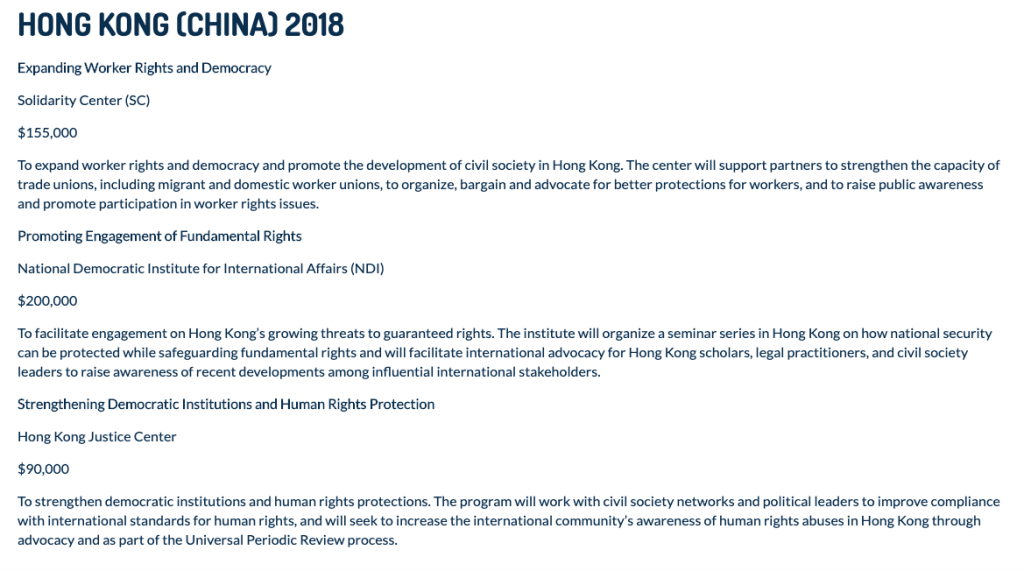
While US lawmakers nominate Hong Kong protest leaders for peace prizes and pump their organizations with money to “promote democracy,” the demonstrations have begun to spiral out of control.
From the “Marginal Violence Theory” to the mob violence reality
After the extradition law was scrapped, the protests moved into a more aggressive phase, launching “hit and run attacks” against government targets, erecting roadblocks, besieging police stations, and generally embracing the extreme modalities put on display during US-backed regime-change operations from Ukraine to Venezuela to Nicaragua.
AJE in position to cover HK protesters' "hit and run strategy."
Here's William Engdahl on Otpor!, the CIA-backed Serbian group that trained thousands of youth activists in countries around the world in color revolution swarming tactics: https://t.co/jvCk2QBNhK https://t.co/I8oGScbpsS pic.twitter.com/a3JZzGwDb9
— Max Blumenthal (@MaxBlumenthal) August 13, 2019
The techniques clearly reflected the training many activists have received from Western soft-power outfits. But they also bore the mark of Jimmy Lai’s media operation.
In addition to the vast sums Lai spent on political parties directly involved in the protests, his media group created an animated video “showing how to resist police in case force was used to disperse people in a mass protest.”
While dumping money into the Hong Kong’s pro-US political camp in 2013, Lai traveled to Taiwan for a secret roundtable consultation with Shih Ming-teh, a key figure in Taiwan’s social movement that forced then-president Chen Shui-bian to resign in 2008. Shih reportedly instructed Lai on non-violent tactics to bring the government to heel, emphasizing the importance of a commitment to go to jail.
According to journalist Peter Lee, “Shih supposedly gave Lai advice on putting students, young girls, and mothers with children in the vanguard of the street protests, in order to attract the support of the international community and press, and to sustain the movement with continual activities to keep it dynamic and fresh.” Lai reportedly turned off his recording device during multiple sections of Shih’s tutorial.
One protester explained to the New York Times how the movement attempted to embrace a strategy called, “Marginal Violence Theory”: By using “mild force” to provoke security services into attacking the protesters, the protesters aimed to shift international sympathy away from the state.
But as the protest movement intensifies, its rank-and-file are doing away with tactical restraint and lashing out at their targets with full fury. They have thrown molotov cocktails into intersections to block traffic; attacked vehicles and their drivers for attempting to break through roadblocks; beaten opponents with truncheons; attacked a wounded man with a US flag; menaced a reporter into deleting her photos; kidnapped and beat a journalist senseless; beat a mainland traveler unconscious and prevented paramedics from reaching the victim; and hurled petrol bombs at police officers.
A Hong Kong protester continued to attack Chinese reporter for @globaltimesnews with American flag 🇺🇸 even as Paramedics finally freed him from the crowd and tried to rush him to hospital pic.twitter.com/AIULKRW76t
— Carl Zha (@CarlZha) August 13, 2019
The charged atmosphere has provided a shot in the arm to Lai’s media empire, which had been suffering heavy losses since the last round of national protests in 2014. After the mass marches against the extradition bill on June 9, which Lai’s Apple Daily aggressively promoted, his Next Digital doubled in value, according to Eji Insight.
Meanwhile, the protest leaders show no sign of backing down. Nathan Law, the youth activist celebrated in Washington and photographed meeting with US officials in Hong Kong, took to Twitter to urge his peers to soldier on: “We have to persist and keep the faith no matter how devastated the reality seems to be,” he wrote.
Law was tweeting from New Haven, Connecticut, where he was enrolled with a full scholarship at Yale University. While the young activist basked in the adulation of his US patrons thousands of miles from the chaos he helped spark, a movement that defined itself as a “leaderless resistance” forged ahead back home.
____________________________________________________
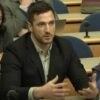 Dan Cohen is a journalist and co-producer of the award-winning documentary, Killing Gaza. He has produced widely distributed video reports and print dispatches from across Israel-Palestine, Latin America, the US-Mexico border and Washington DC. Follow him on Twitter @DanCohen3000. http://www.dancohenmedia.com/
Dan Cohen is a journalist and co-producer of the award-winning documentary, Killing Gaza. He has produced widely distributed video reports and print dispatches from across Israel-Palestine, Latin America, the US-Mexico border and Washington DC. Follow him on Twitter @DanCohen3000. http://www.dancohenmedia.com/
Go to Original – thegrayzone.com
Tags: Alt-right, CIA, China, Freedom house, Hong Kong, Jimmy lai, John Bolton, Marco Rubio, National Endowment for Democracy, Neoconservatives, Protests, Trump
DISCLAIMER: The statements, views and opinions expressed in pieces republished here are solely those of the authors and do not necessarily represent those of TMS. In accordance with title 17 U.S.C. section 107, this material is distributed without profit to those who have expressed a prior interest in receiving the included information for research and educational purposes. TMS has no affiliation whatsoever with the originator of this article nor is TMS endorsed or sponsored by the originator. “GO TO ORIGINAL” links are provided as a convenience to our readers and allow for verification of authenticity. However, as originating pages are often updated by their originating host sites, the versions posted may not match the versions our readers view when clicking the “GO TO ORIGINAL” links. This site contains copyrighted material the use of which has not always been specifically authorized by the copyright owner. We are making such material available in our efforts to advance understanding of environmental, political, human rights, economic, democracy, scientific, and social justice issues, etc. We believe this constitutes a ‘fair use’ of any such copyrighted material as provided for in section 107 of the US Copyright Law. In accordance with Title 17 U.S.C. Section 107, the material on this site is distributed without profit to those who have expressed a prior interest in receiving the included information for research and educational purposes. For more information go to: http://www.law.cornell.edu/uscode/17/107.shtml. If you wish to use copyrighted material from this site for purposes of your own that go beyond ‘fair use’, you must obtain permission from the copyright owner.
Read more
Click here to go to the current weekly digest or pick another article:
ANALYSIS:
- Why Do Governing Elites Support Harmful Policies?
- Israel-Hizbullah-Nasrallah—An Analysis
- Ten Theses on the Far Right of a Special Type
ANGLO AMERICA:
- Preparing to 'move on', US says Ukraine is 'not our war'
- Close Military Bases, Not Embassies
- "They're Kissing My Ass": Trump Says Tariffs Are Going Great, Promises Duty on Pharmaceuticals
ASIA--PACIFIC:
- The Hawai’i Land Grab — And Trump's Thirst for Greenland
- Historian on How Tariffs Played a Role in the Overthrow of the Hawaiian Kingdom
- Identity Politics, Sexual Politics, and Violence against People in Sri Lanka
BRICS:
- The “BRICS Sovereigns” vs the “Globalist Oligarchy”
- Cuba Joining BRICS Is a Lifeboat for Its Economy
- BRICS and G20 Value Platforms: A Comparative Analysis
MEDIA:
